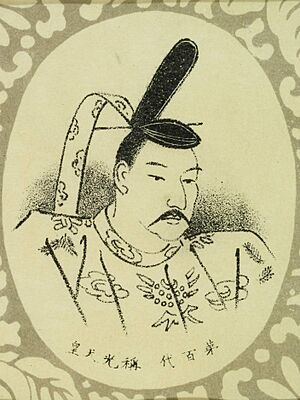Emperor Shōkō facts for kids
Quick facts for kids Emperor Shōkō称光天皇 |
|||||
|---|---|---|---|---|---|
 |
|||||
| Emperor of Japan | |||||
| Reign | October 5, 1412 – August 30, 1428 | ||||
| Coronation | January 29, 1415 | ||||
| Predecessor | Go-Komatsu | ||||
| Successor | Go-Hanazono | ||||
| Shōgun | Ashikaga Yoshimochi Ashikaga Yoshikazu |
||||
| Born | Mihito (躬仁 / 実仁) May 12, 1401 |
||||
| Died | August 30, 1428 (aged 27) | ||||
| Burial | Fukakusa no kita no Misasagi (深草北陵) (Kyoto) | ||||
| Issue | 2 daughters | ||||
|
|||||
| House | Yamato | ||||
| Father | Emperor Go-Komatsu | ||||
| Signature |  |
||||
Emperor Shōkō (称光天皇, Shōkō-tennō, May 12, 1401 – August 30, 1428) was the 101st emperor of Japan. He ruled from 1412 to 1428.
Contents
Emperor Shōkō's Family and Name
Emperor Shōkō's personal name was Mihito. He was the oldest son of Emperor Go-Komatsu. His mother was Hinonishi Motoko.
Emperor Shōkō did not have any sons. Because of this, his third cousin, Emperor Go-Hanazono, became the next emperor. Go-Hanazono was the great-grandson of Emperor Sukō.
The name "Shōkō" comes from two earlier emperors. It uses one kanji character from Empress Kōken (who was also called Empress Shōtoku) and one from Emperor Kōnin.
- Empress Shōtoku (称徳)
- Emperor Kōnin (光仁)
- Together, these names formed "Shōkō" (称光).
Key Events During Shōkō's Reign
Emperor Shōkō ruled Japan from October 5, 1412, until his death on August 30, 1428.
Becoming Emperor
Shōkō became emperor after his father, Go-Komatsu, stepped down. This happened on October 5, 1412. His official crowning ceremony took place two years later.
Even though Shōkō was the emperor, his father, Go-Komatsu, still had a lot of power. Go-Komatsu ruled as a "Cloistered Emperor". This means he had retired but still guided the court.
Shōkō was only 12 years old when he became the formal head of the Daïri (the imperial court). The Shōgun, Ashikaga Yoshimochi, was in charge of managing the country's general affairs.
Important Dates and Happenings
- October 5, 1412: Emperor Shōkō officially became the new ruler after his father, Emperor Go-Komatsu, stepped down.
- 1413: The Shōgun, Ashikaga Yoshimochi, became very sick. He sent someone to the Ise Shrine to pray for his health.
- January 29, 1415: Emperor Shōkō's official crowning ceremony took place. This was two years after he first took on the role of emperor.
- 1418: Shōgun Ashikaga Yoshimochi ordered the Asama Shrine to be rebuilt. This shrine is located at the base of Mount Fuji.
- July 18, 1419: The Oei Invasion happened. Korea invaded Tsushima Province, an island of Japan.
- 1423: Shōgun Yoshimochi retired. His son, Ashikaga Yoshikatsu, became the new Shōgun at 17 years old.
- March 17, 1425: Shōgun Yoshikatsu died at the age of 19. He had only been in charge for three years.
- February 3, 1428: Shōgun Ashikaga Yoshimochi died at 43. He had taken power again after his son's death.
- August 30, 1428: Emperor Shōkō died at the age of 27.
Succession After Shōkō
Since Emperor Shōkō had no sons, his father, Emperor Go-Komatsu, chose an heir for him. This heir was Shōkō's third cousin. He became the next emperor, Emperor Go-Hanazono, at the age of 10. He took the throne on September 7, 1428.
Emperor Shōkō is buried with other emperors. His tomb is called Fukakusa no kita no Misasagi in Fushimi-ku, Kyoto.
Court Officials (Kugyō)
The Kugyō (公卿) was a small group of very powerful men. They worked closely with the Emperor of Japan in ancient times. Even when the emperor's power outside the palace was small, these officials were very important.
This group usually had only three or four men at a time. They were often from noble families. They had a lot of experience and were at the top of their careers. During Emperor Shōkō's reign, some of these top positions included:
- Sadaijin (Minister of the Left)
- Udaijin (Minister of the Right)
- Nadaijin (Minister of the Center)
- Dainagon (Chief Counselor)
Eras During Shōkō's Rule
In Japan, years are also named after special periods called era names or nengō. Emperor Shōkō's reign included these eras:
See also
- Emperor of Japan
- List of Emperors of Japan
- Imperial cult
| Regnal titles | ||
|---|---|---|
| Preceded by Emperor Go-Komatsu |
Emperor of Japan: Shōkō 1412–1428 |
Succeeded by Emperor Go-Hanazono |

